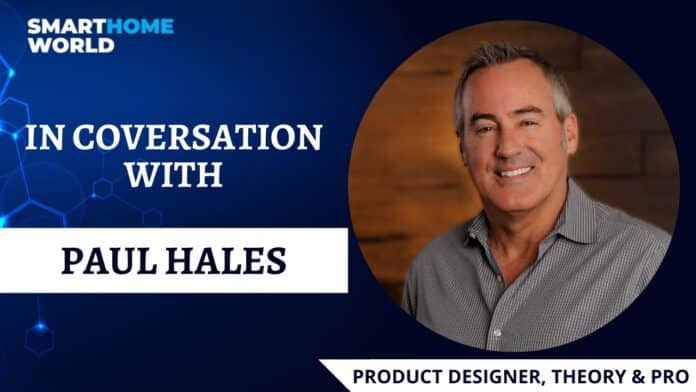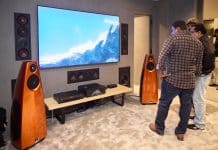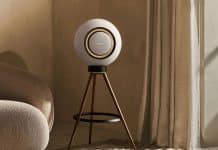
Paul Hales, President and Product Designer at Theory Audio Design (Theory) and Pro Audio Technology (PRO) discusses his distinctive product line and upcoming expansion plans.
In this competitive speaker market, Theory is a relatively new entrant. How do you differentiate Theory from other competitors?
It’s true that Theory is different. Our overarching goal is to establish ourselves as the “Porsche” of audio devices. A limited stable of our most cutting-edge products will help us build our brand as a premium one. In every product area, we pledge to provide the best performance that is currently possible. It’s a huge boast, but our first line of Theory products—which includes soundbars, on-wall loudspeakers, subwoofers, in-wall and in-ceiling/pendant speakers, as well as loudspeaker controllers—has already gotten excellent feedback. Consumers, dealers, consultants, and journalists have all expressed agreement that we have set a new standard for these goods’ performance. We want to release architectural subwoofers later this year that can be mounted in-wall, on-wall, suspended from the ceiling, or freestanding.

What would you say is the key USP of the brand/product range? Is it performance? Power or Technology?
Performance, Power, and Premium Technology, all three, I would say! Utility is another important USP of our product line. Without the need to specify several models, we make sure that each product category offers a wide range of installation or application possibilities, whether they are for home or commercial use. The top items on the market are part of this small but incredibly capable family.
It’s unusual to have a product range that targets both residential and commercial clientele. What are your thoughts on a dual market strategy?
The line between residential and commercial segments is blurring. We have seen many integrators diversify into the newer market. Since commercial spaces are becoming increasingly more refined and high-end, they require products that can match professional expectations. Our brand designs product range specifically to address the premium niche buyers/users. Consumer audio is dominated by floor or stand-mount style loudspeakers, typically with delicate cones and domes for components. The speakers are designed for hi-fi and two-channel listening, offering a sound that is accurate and refined.
Commercial audio is primarily dominated by small plastic speakers or for foreground music, large horn-based PA boxes. Commercial loudspeaker components are strong and durable meaning they can play loud and offer massive dynamics, but the sound can lack clarity and refinement.

Theory products merge the refined sound of hi-fi equipment, with the thrilling dynamics of professional gear. Plus, combining that with smart design and Theory product range is a welcome addition in both residential and commercial markets. They are thoughtfully designed and their high-performance speakers do not need SKUs.
With all your brands, you match amplification and speakers. Do you have any plans of making powered speakers in the future? Most brands seem to be heading in that direction.
It’s best to think of all Theory loudspeakers (and PRO too, for that matter) as powered speakers; we’ve just placed the electronics in a separate rack-mount enclosure where they are easy to install and service. Powered loudspeakers require high voltage at every speaker location. Running AC to every speaker is not only impractical, in many installations, but it’s also impossible. So, while powered speakers may be a good solution for simple two-speaker installations (studio monitors or stereo listening for example), they are not good solutions for complex surround or distributed audio solutions.
However, there is one exception to this philosophy: subwoofers. We do have plans to introduce the Theory in-room subwoofers in powered versions for two distinct reasons: Firstly, one of our subs offers class-leading performance and powered versions would let us capture some subwoofer-only business (users could add them to their existing non-Theory systems; and two, even in complex surround installations there are generally two subwoofers that typically sit on the floor, so getting AC power to them is simple.

You already have a premium loudspeaker brand – PRO Audio Technology. Would Theory eat into PRO’s market?
Theory is intended to work in conjunction with PRO and is targeted toward non-high-end commercial audio applications, distributed audio systems, and surround sound systems for media rooms, outdoor settings, etc. Pro Audio Technology (PRO) focuses on medium-to-large commercial installations as well as extremely upscale home theatres.
In order to provide solutions for any type of installation and budget, with systems ranging from $6K to $250K and beyond, PRO and Theory are highly complementary to one another.
The Theory range is quite limited but has multiple usage applications. Was that intentional?
Absolutely! Theory was created particularly to provide a condensed selection of highly functional products that can be integrated into any setting. There is no justification for providing numerous models under the same product category. Theory provides one, two, or three high-performance options in each product category, along with accessories that go with them so they can be placed in surround sound and distributed audio systems for both indoor and outdoor use in homes and businesses.
The Theory product line is purposefully limited, but don’t be fooled by this; Theory can handle practically any small- to medium-sized project with the best performance possible.

What new products can we expect from Theory in the coming years?
Late 2022, Theory will expand the DLC distributed loudspeaker controller line with two additional models. The DLC-1000.4 and DLC-1500.4 are ideal for any residential or commercial installation where high-power distributed or surround audio is needed. With channel-pair power-sharing of up to 1000W for the DLC-1000.4 or 1500W for the 1500.4, each DLC offers the flexibility to power any system size. Via their configurable outputs, the DLC models can power up to 16 Theory 16-ohm ceiling or pendant loudspeakers in Lo-Z mode, and the DLC-1500.4 can power up to 200 Theory architectural speakers in Hi-Z mode – or an optimal hybrid of both or in any quantity in between. The DLC distributed loudspeaker controllers also offer a full DSP matrix and are TCP/IP controlled through a wired connection, or directly via the on-board Wi-Fi access point.
Early 2023, Theory will begin shipping the recently announced iws12-6 and iws12-9 architectural subwoofers. Equipped with 12-inch, 1,400 Watt, 4-inch voice coil long-throw woofers, and the ability to be installed in-wall, on-wall, ceiling mounted or flown, there isn’t an installation environment Theory’s new subwoofer models cannot handle.
With the addition of these new models, the Theory line will be complete. But of course, we have more up our sleeves in terms of product development and will be adding more high-performance and cleverly designed audio products in the years to come with more outdoor options, including landscape solutions coming first.

What are your expectations of the Theory business in India? How has your experience been with PRO FX so far?
Absolutely! Theory was developed specifically to offer a streamlined range of extremely useful products that can be included in any environment. Multiple models being offered under the same product category is not justified. In each product category, Theory offers one, two, or three high-performance alternatives together with the corresponding accessories so they may be installed in distributed and surround sound systems for both indoor and outdoor use in homes and businesses.
Though the Theory product range is intentionally small, don’t let that mislead you—the greatest performance is capable of handling nearly any small- to medium-sized job.















